|
~~ River Queen Strip Mine! ~~
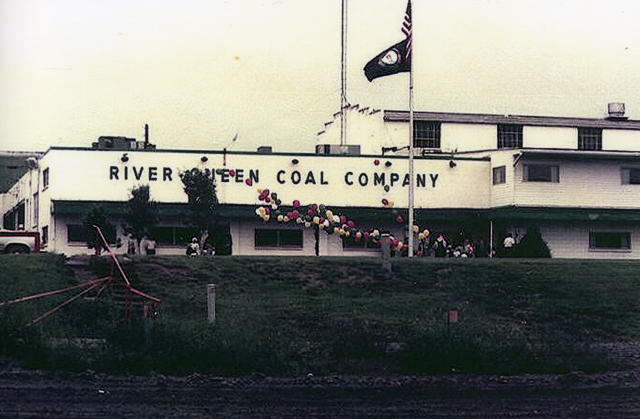
Peabody's River Queen Mine Office.
In 1956, Peabody Coal Company became partners with W. G. Duncan Coal Company
for a new mine in Muhlenberg County and River Queen mine was born. This new
mine was located west of Central City, Kentucky and mostly in an area bounded
by State Highway 70 on the North, County Road 175 on the West and the Western
Kentucky Parkway on the South. To the East, the mine area was almost to Central
City, to Powderly and neared Greenville. The supply of coal was plentiful and
this mine would continue operation for the next 35 or so years. Although the
mine was in Muhlenberg County, it would employ a lot of miners from Rockport
and Ohio County. Peabody would eventually buy out W. G. Duncan Coal Company,
but for several years, the mine was owned by the joint ownership and operated
by Peabody Coal Company.
After several years of operating out of small shelters for office and management,
a large office and maintenance complex was built. It was located near County
Road 181 and just to the South of Highway 70. Easy access to the mine area was
just a short drive for Central City and Greenville residents and not much farther
for the residents of Ohio and Hopkins Counties. A few years later, Peabody
decided to add to the Office/Garage/Warehouse area and built an office complex
for area management. The offices for the River Queen mine was on the second
floor and to the right of the complex. Divisional Offices were on the first floor
and to the right. The "Garage" was to the left and to the rear of the complex.
A large warehouse was in front of the garage. The tall building in the background
of the picture is a "Wielding and Large Equipment Shop". Peabody was expanding
by leaps and bounds and a new Divisional Office Complex was staffed. Management
of Peabody Western Kentucky Mines would now be controlled from this new compound.
In the mid nineteen-forties, Jackson Construction Company purchased some land in
the Echols, Kentucky area and walked a Marion 40D Shovel from Centertown to the
new mine. This small company was non-union and before any coal could be mined,
the United Mine Workers Of America established a "Picket Line" and the mine was
shut down. This "Strike" lasted some nine months and Jackson Construction Company
would not agree to union representation and sold the property to Kessler Brothers
Coal Company. Kessler Brothers Coal Company signed an agreement with the UMWA,
but before very much coal could be mined, sold the new Ken Mines to Peabody Coal
Company. In 1946 Peabody Coal Company became established in Ohio County and
signed an agreement with the United Mine Workers Of America. Now, a new era began
and coal mining at the Ken Mine could finally start.
After a few years of operation at Ken Mine, Peabody Coal Company must have
considered their investment to have been a good one. The area conditions were
favorable for mining the coal and of making a profit. The area work force
contained a lot of ex-veterans, most with a high school education, and they were
ready and willing to become good company employees. The young high school
graduates, from Rockport and other areas, were having to go north for work and
jumped at a chance for a local job. In the early fifties, Peabody started
opening a few more area mines. The River Queen Mine was one of these mines.
~~ BE 1650B "River Queen" ~~
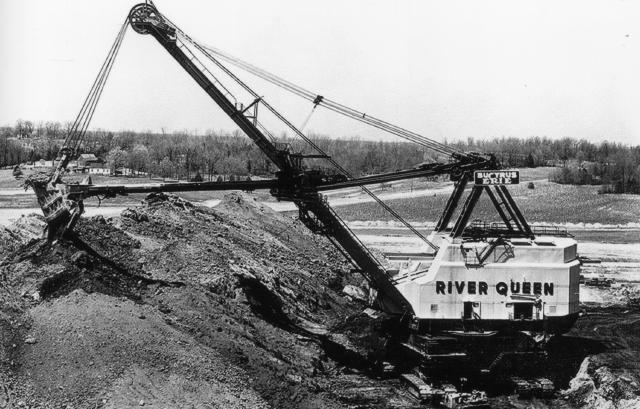
Peabody's River Queen Mine Shovel-A BE 1650B.
When a "Strip Mine" is first started, a lot of mining equipment, as well as an
office complex, will eventually be built or purchased. A means of removing the
"Overburden" is one of the first needs. River Queen Mine started initial mining
operations in 1956 with a new BE 1650B, 55 Yard Shovel. This new shovel picked
up the name of "The River Queen" after the mine that built her. A few years
later, this 55 Yard shovel would seem small, but in 1956 with a new digging
shovel that large, this mine started off in grand form. All pieces of equipment
eventually "Wear-Out" and/or are severely damaged by misuse, by accidents, or by
metal fatigue and "Stripping Shovels" are no exception. This new shovel, in 1956,
operated several years before it had a "Boom Failure". After a boom failure to
a mine's "Stripper", doubt and uncertainty are on the mind of the miners. With
a "Can-Do" mentality, this massive machine was brought back to life in near
record time. Although the repair cost was in the neighborhood of a quarter of
a million dollars, this machine started digging again in about two weeks. After
operating for a little over 10 years at "River Queen", the BE 1650B was replaced
by a Marion 5960 Shovel. The BE 1650B was walked across Highway 175 to begin
operations at the Peabody's Vogue Mine. When the Vogue Mine was shut down, the
BE 1650B was then dismantled and sent to Peabody's Riverview Mine. From there,
it was sold to Green Coal Company. I think that is has since been scrapped.
~~ Marion 5960 "The Big Digger" ~~
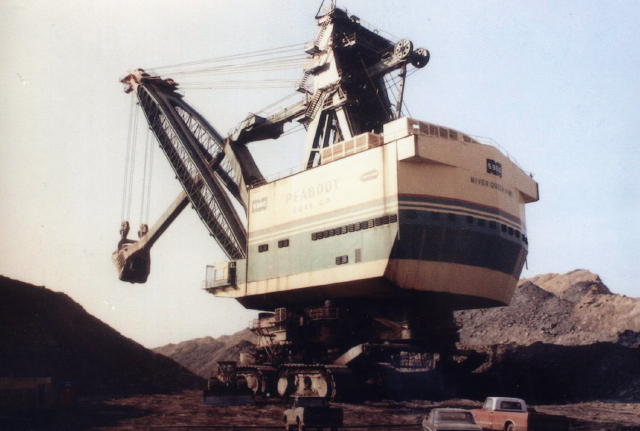
Peabody's River Queen Mine Shovel-A Marion 5960.
This new Marion 5960-M shovel was a monster machine. The "Bucket" was a 125
Yard capacity behemoth and almost twice as large as the bucket on the BE 1650B
machine that it replaced. Guess one can see why it picked up the name of
"The Big Digger". From about 1969 until 1989, or a period of over twenty years,
this monster shovel became a leader in the removal of "Overburden". "The Big
Digger" was a very dependable machine. It was operated and maintained by experienced
miners. In 1982, it set a record for the "Best Run Time" efficiency by being
operational for 85% of the time. That record may still stand. In just one year(1982),
the year the "best Run Time" record was set, this huge machine stripped 178.11 acres.
Those acres consisted of 33,524,007 cubic yards of overburden being removed. That
figure is 1,046,778 tons of earth and rock. Impressive. Please note that this
"Spoil" was later reclaimed and today, a person can walk over the land that is habitable
for cattle and wildlife.
By the time the year 1990 rolled around, most of the River Queen coal reserves
had been depleted and it was time to close a very good mine that had been in
continuous operations for almost thirty-five years.
~~ River Queen Tipple ~~
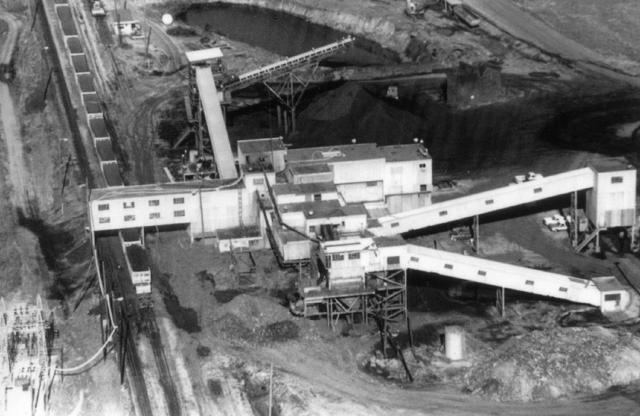 The River Queen Tipple.
The River Queen Tipple.
The River Queen Mine was enormous in about every aspect. From the multi-purpose
office complex, to the large shovels and to the modern tipple, this mine was
somewhat different that all others. The tipple was a "Coal Processing" plant.
The raw coal, from the "Pit" area, was delivered by large trucks that could dump
their loads of coal, non-stopping, into the large underground hoppers. This
coal was then transported by belts to the "Wash Plant". The "Wash Plant" would
clean the coal, which would then be sent to hoppers, where it could be
transported, again by belts, to different shipping sections. The waste
byproducts were sent to a "Slurry Pit" where it was pumped via large pipes to a
"Slurry Holding Pond". With hoppers full of clean coal, a selection could be
made as to where to sent it out for shipment to customers. The main mode of
shipment was by River Queen's own railroad. River Queen built a railroad of
about ten miles that stretched from the "Tipple" to a "Barge Loading Facility"
on the Green River. The "Peabody Train" was built, operated, and maintained by
"River Queen" miners. Two, three, four and more loads a day were filled from
the tipple "Rail Loading" section and transported to the "Barge Loading"
facilities on the Green River. This train track was also tied into an outside
line where the could be loaded on other rail cars and shipped to anywhere in
the country. There was also a "Truck Hopper", but this was very seldom used.
At one time, a rail car was positioned under this hopper, and kept full of clean
coal, so the miners could purchase coal for home use.
~~ BE 270B Loader ~~
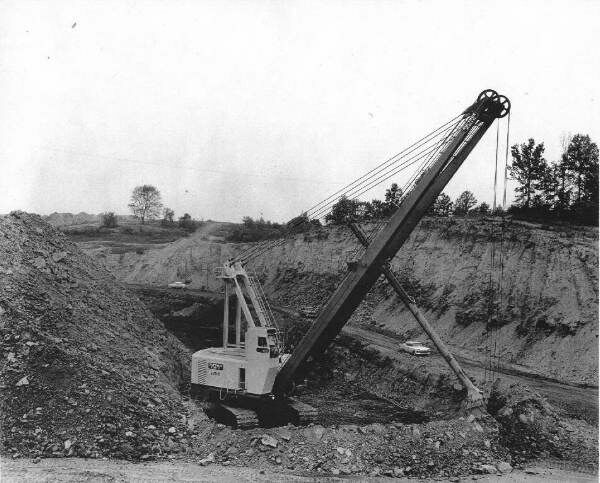
The BE 270B Loader.
River Queen Mine had an assortment of equipment that seemed to extend from one
end of the machinery scale to the other. I guess that all mines have, to a
certain extent, likewise conditions, but it seem that River Queen was more to
the extreme. This BE 270-B Loader is a fine example. A "Coal Loader" is a coal
digging machine, the function of which is to operate in the "Pit" and dig up the
coal that the "Stripper" has uncovered. In reality, they are smaller versions
of the strippers. The loader operates on the same level as the coal seam and
can load the "Haul Trucks", which can enter the pit on the coal seam or the
area where the coal has been dug. If a ten foot seam of coal is being loaded
and the haul truck is on top of the coal seam, the boom of the loader would
only have to reach to the top of the bed of the truck. For instance, if the
bed of the truck was twenty feet high and the coal seam was ten, it would take
a boom of thirty feet to load the truck. There was not that many ten foot coal
seams in the state of Kentucky, thus most of the loader booms were less than
forty feet in length. Are you getting ahead of me? Well, the boom on this
BE 270B Loader was a hundred feet in length. It was built in the fall of 1960
at the River Queen and operated there for a few years. It had a 9 Yard bucket
and that massive 100 foot boom. After about three years of operation, it was
"Walked" to Peabody's Vogue Mine and spent some time as a loader and some time
idle. The decision was made to remove twenty feet of the boom. Ten feet of
boom was cut off each end and in the early seventies, it was walked back to
River Queen and continued loading for several more years.
~~ Diesel Dragline ~~
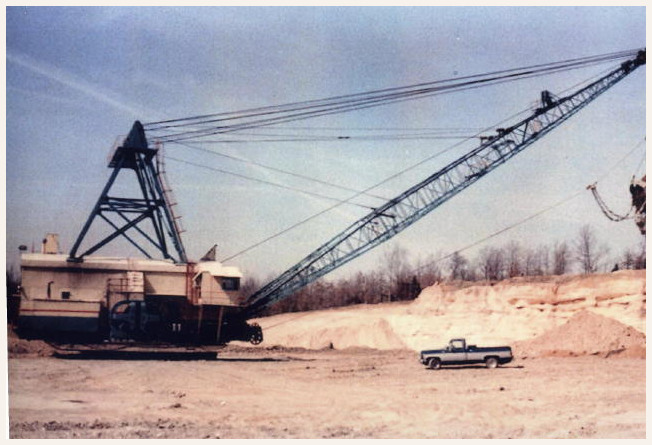 The River Queen Diesel Dragline.
The River Queen Diesel Dragline.
Another machine that was not quite a normal "Run-Of-The-Mill" piece of equipment,
for a large strip mine, was the BE 450 W Diesel Dragline. In the forties, this
type of dragline would have been the norm, but in 1956 it was outdated. It was
just a little large too be used for digging ditches and a little small for stripping.
Regardless of whether it was out of place or not, it was certainly used at the
River Queen Mine. It was one of the first pieces to become operational at River
Queen Mine and one of the last to be shut down. The 450 W Dragline had a diesel
powered, locomotive engine and thus, was not limited in operation by an electrical
power source. There was some idle time, but for the most part, this old and
small dragline kept busy. A year or so before the mine was closed, this machine
was cut in half, loaded on large trucks, and crossed under Western Kentucky
Parkway. It was then welded back together and placed in operation where it stripped
on the South side of the parkway for several months. By now, River Queen had run
out of coal and a "Shut Down" mode was started. From 1956 until about 1990, a
period of almost 35 years, this grand old mine removed the coal from Western Kentucky,
help make a profit for Peabody Coal Company, provided a means for earning a living
for hundreds of coal miners, was a major source of revenue for Muhlenberg County,
and a main contributor for the economy of Kentucky as well as several counties
in the area. Countless small companies were started and most survived by providing
some type of a service to the River Queen Mine. The BE 450 W played a major part
in this overall operation. I think the old dragline was salvaged after the operation
on the South side of the Western Kentucky Parkway.
As always, if you are still reading this printed material, thanks for your time
and patience. Without any readers or lookers, this web page would be for naught.
:)
See you..........
jrd
|